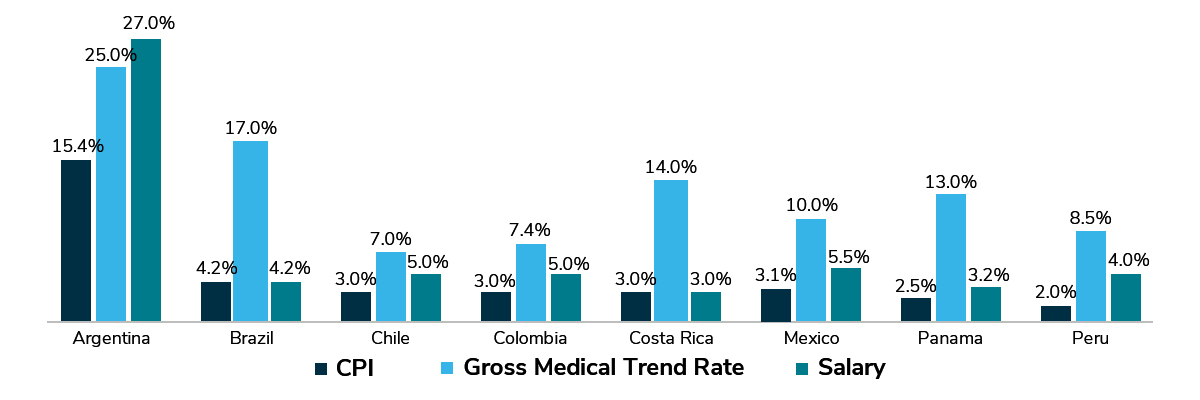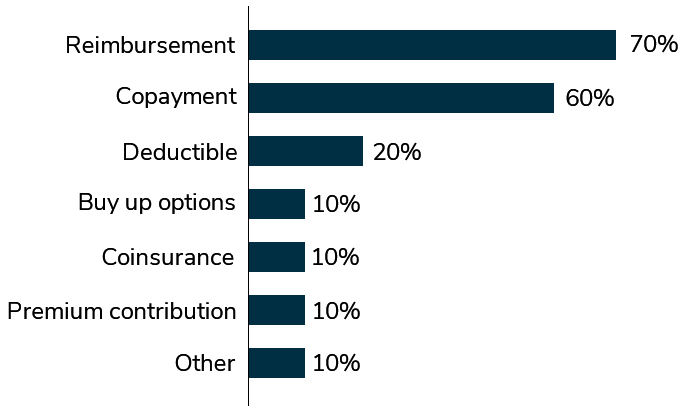January 11, 2020
Employers in Brazil face a range of challenges as they struggle to address medical inflation. Companies shared their efforts with medical plan offerings, well-being initiatives and non-health benefits. Topics included employee cost-sharing efforts, claims data audits and analytics, right-to-health litigation injunctions, primary and maternity care, occupational health regulations and well-being integration, employee assistance program (EAP) and mental health offerings, well-being efforts to control health care costs, and retirement benefits.
Twenty-four attendees from 13 companies participated in the call. Companies came from various industries, including telecommunications, consumer products/apparel/household, banking/financial services, manufacturing, professional services and technology.
The Global Institute hosted a 60-minute member conversation about health and benefits in Brazil. Call content was driven by attendees based on standard market practice in medical and health benefits offerings and other health promotion priorities in Brazil.

Source: Aon Gross Medical Trend Rate Survey Report, Korn Ferry Global Salary Increases 2019
Health Care Costs
In 2019, Brazil had double-digit health care cost increases, which is four times higher than general inflation (CPI) and salary increases (see Fig. 1).1,2 Employers are looking at different ways to control health care costs through cost-sharing strategies, claims audits and health promotion efforts.
Medical Benefits
Employers use various cost-sharing mechanisms to control costs and utilization. In terms of employee cost-sharing strategies, most employers on the call have copays or a reimbursement model (Fig. 2). The percent of copays varies from 10% to 30%. For reimbursement mechanics, employers use percent of employees’ gross salary per month. One company has a deductible for hospitalization. The companies are hoping to see changes in behavior, but there is high utilization.

Sixteen percent of respondent employers are self-insured in Brazil.3 Those companies have greater access to claims data analytics and auditing efforts. Some self-insured employers have doctor panels and third-party administrator (TPA) reviewing medical bills and utilization to find ways to manage costs. A fully insured company uses its broker to review claims and manage costs. TPA oversees disease management and pregnancy programs. One major challenge is that self-insured employers are trying to get a handle on right-to-health litigation injunctions where employees sue for access to certain services. Companies are trying to balance meeting employees’ needs, evidence-based care and escalating health care costs.
Maternity claims in Brazil are often a high utilization driver, with the frequency of certain tests and exams not always evidence- based. One company developed a maternity program where employees who follow a specific schedule of visits, exams and tests receive a more generous benefit. The program doesn’t include any preferences for vaginal childbirth versus Caesarean sections. The program’s schedule removes services that lack evidence and reduce cost. Another company has a similar program through a vendor. Employees who participate in the program have their copayments waived. The company also provides a new baby kit to employee families when the child is born.
One area of common struggle is that employees not accessing primary care. Some companies are planning to use their on-site clinics to address this need. One company is monitoring emergency room care utilization and trying to promote primary care.
| Rank | Ages 15-49 | Ages 50-69 | ||
|---|---|---|---|---|
| Women | Men |
Women |
Men |
|
| 1 | Headache disorders | Interpersonal violence | Ischemic heart disease | Ischemic heart disease |
| 2 | Low back pain | Road injuries | Stroke | Stroke |
| 3 | Anxiety disorders | Low back pain | Diabetes | Diabetes |
| 4 | Depressive disorders | Alcohol use disorders | Low back pain | Cirrhosis |
| 5 | Dietary iron deficiency | Headache disorders | COPD | Low back pain |
| 6 | Road injuries | Ischemic heart disease | Breast cancer | COPD |
| 7 | Other musculoskeletal disorders | Self-harm | Headache disorders | Lower respiratory infections |
| 8 |
Interpersonal violence | HIV/AIDS | Depressive disorders | Road injuries |
| 9 | Gynecological diseases | Drug use disorders | Lower respiratory infections | Lung cancer |
| 10 | Stroke |
Cirrhosis | Chronic kidney disease | Chronic kidney disease |
Source: Institute for Health Metrics and Evaluation Global Burden of Disease (GBD) Compare 2017
Occupational Health
Companies have occupational health staff to meet stringent regulations. Companies would like to engage their occupational health staff in their well-being efforts. The main challenge is their lack of bandwidth to add well-being to their existing responsibilities given all the occupational health regulations and procedures they must follow. One company’s occupational health doctor is part-time. One company has integrated well-being aspects (e.g., sleep, musculoskeletal) in required occupational health assessments by tying occupational health and well-being together. Companies are also trying to integrate emotional/mental well-being as well.
Well-being
To tackle high health costs and utilization, companies are focusing on health promotion efforts in Brazil. Several companies are using claims analysis data to help create health programming for their employee population needs. One company implemented a global well-being platform (through a vendor) that addresses financial, mental and physical health. The company hopes to engage employees in their holistic well-being and preventive care to reduce health care costs. Another company has a health committee that meets bimonthly to address health and well-being issues and programming.
Well-being efforts that employers offer in Brazil:
- Discounts on well-being related equipment and services;
- EAP;
- Financial education;
- Healthy food access (via food carts);
- Meditation;
- On-site psychologist;
- Physical activity challenges;
- Preventive health services;
- Well-being platform; and
- Yoga
Mental Well-being
Employers have different approaches to addressing mental health. One company negotiated unlimited mental health support (specifically psychiatrist visits) with their health plan provider. Another company has an on-site psychologist who is available through an online registration system and meeting space is secluded from the main workspace for privacy. The company also has a 15% EAP utilization rate, which is similar to other large locations in the Latin America region. This rate was achieved through communication efforts. A third company incorporates anxiety and depression screening tools into required medical exams. Screening tools are in line with U.S. Preventive Services Task Force recommendations.
Pensions
Companies are reviewing their pension plans as the Brazilian government makes changes to retirement regulations. Brazil has increased the retirement age to 65 for men and 62 for women, as people are living longer. Companies are looking at ways to engage employees in their retirement benefits:
- Providing flexibility and what that means for employer contributions; and
- Considering whether an employer match is competitive.
Leave and Childcare Policies
Corporate leave strategies in Brazil are driven by compliance with mandates, local market practice and a company’s overall global strategy. Additionally, many large employers in Brazil participate in the Corporate Citizen Program (Programa Empresa Cidada), which encourages employers to provide childcare and extend maternity and parental leave; in turn, participating companies are given tax benefits.
The list below describes the advantages of the Corporate Citizen Program.
Vacation
According to the Brazilian consolidation of labor laws (Consolidacao das Leis do Trabalho), employees with a 1-year tenure have the right to 30 vacation days per year. The time off is often accrued and does not carry over. Since this provides employees with more vacation time than employees in other LATAM countries, most employers do not provide additional time off beyond the 30 days. Beyond vacation leave, one employer member offers 92 unpaid days of personal leave in Brazil. Another has a unique global “recharge” policy that provides 30 days of paid PTO (in addition to regular PTO) to all employees every 5 years; this “recharge” time away must be taken all at once.Maternity & Paternity Leave
The Corporate Citizen Program requires participating employers to provide 6 months of maternity leave and 20 days of paternity leave. Companies vary their approaches beyond requirements of the law and Corporate Citizen Program. For example, one employer member extends paternity leave up to 120 days for fathers. This company also noted that maternity leave must be taken consecutively; however, paternity leave can be taken intermittently within 1 year of the child’s birth or adoption. Another employer company shared that adoptive parents receive 6 months, matching the maternity benefit. A third employer explained that while there are not local requirements, it also provides 6 months for primary caregivers and 20 days for secondary caregivers when the employee becoming a parent is in a same-sex relationship.
The Leave and Family-Friendly Benefits Guide provides an overview of statutory requirements in Brazil and other countries across the globe.
Childcare
Some employers offer allowances for new children and childcare. For example, one employer has a baby allowance, paid at birth or adoption, to employees. Other employees provide a childcare reimbursements or allowance, sometimes dependent on union agreement.
Business Group Resources
Americas
More Topics
Articles & Guides- 1 | Aon. 2020 Global medical trend rates report. 2019. https://healthresources.aon.com/reports-2/2020-global-medical-trend-rates-report. Accessed September 19, 2019.
- 2 | Korn Ferry. Global salary forecast 2019: Smaller real-wage increases predicted for most parts of the world. 2019. https://engage.kornferry.com/Global/FileLib/Pay/KF_2019_Salary_Forecast_Main_Infographic_Aw.pdf. Accessed October 31, 2019.
- 3 | McManus T. Brazil benefits and well-being benchmarking survey results. Business Group on Health. 2017. https://www.businessgrouphealth.org/resources/survey-results-benefits-and-well-being-benchmarking-brazil. Published November 2017. Accessed February 3, 2020.
- 4 | Institute for Health Metrics and Evaluation. Global burden of disease (GBD) compare. 2018. https://vizhub.healthdata.org/gbd-compare/. Accessed January 20, 2020.
This content is for members only. Already a member?
Login
![]()
